|
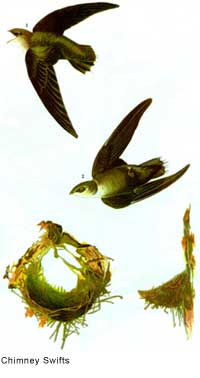 Bird or Boomerang? Many swifts have a characteristic shape, with a short forked tail Bird or Boomerang? Many swifts have a characteristic shape, with a short forked tail
and very long swept-back wings that
resemble a crescent or a boomerang. The
flight of some species is characterized
by a distinctive "flicking" action quite different from swallows.
Swifts and Swallows: While swifts are
superficially similar to swallows, they
are actually not closely related to those passerine species at all; swifts are in
the separate order Apodiformes, which they formerly
shared with the hummingbirds.
Who Needs Feet? The scientific name (Apodidae) comes from the Greek απους, apous, meaning "without feet". These
birds have very short legs which they
use only for clinging to vertical surfaces
(hence the German name Mauersegler, literally meaning "wall-glider"). They never
settle voluntarily on the ground.
Heads in the Clouds: Swifts spend most of their lives in the air, living on the insects they catch in their beaks. They drink and even sleep on the wing. No other bird spends as much of its life in flight.
Bird's Nest Soup: The nest of many species is glued to a vertical surface with saliva, and the genus Aerodramus use only that substance, which is the basis for bird's
nest soup.
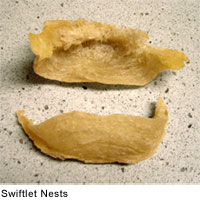 The top image (left) shows the inside of a nest (shown here upside down). The bottom one shows how it would look when stuck on the wall of the cave. The nests are about 3" long in this photo. These nests are still slightly moist hence requires refrigeration though most are sold completely dry. The top image (left) shows the inside of a nest (shown here upside down). The bottom one shows how it would look when stuck on the wall of the cave. The nests are about 3" long in this photo. These nests are still slightly moist hence requires refrigeration though most are sold completely dry.
As of 2005, dried birdnests can be priced between US$1000 to US$3000 per pound
in San Francisco area depending on the type of nest and moisture contents.
The moist variety costs less per pound because it weighs more for the same amount of material. The sample in this picture cost about US $20 each. The nests are double steamed until they are broken into tiny Jello-like bits.
No Food, No Problem: Many young swifts in the nest can drop their body temperature and become torpid if bad weather prevents their parents from catching insects nearby.
-----------------------------------------------------------------------------------------------------------------------------
Common Swift: The Common Swift (Apus apus) is a small bird, superficially similar to the Barn Swallow or House Martin. It is, however, completely unrelated to those passerine species, since swifts are in the separate order Apodiformes. The resemblances between the groups are due to convergent evolution reflecting similar life styles.
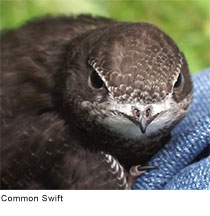 Weights and Measures: Common Swifts are 16-17 cm long and entirely blackish-brown except for a small white or pale gray patch on their chins which is not visible from a distance. They have a short forked tail and very long swept-back wings that resemble a crescent or a boomerang. Weights and Measures: Common Swifts are 16-17 cm long and entirely blackish-brown except for a small white or pale gray patch on their chins which is not visible from a distance. They have a short forked tail and very long swept-back wings that resemble a crescent or a boomerang.
Range and Migration: Like swallows, Common Swifts are migratory, and in midsummer they are found in Great Britain and northern Europe, while they winter much further south in southern Africa. Swifts will occasionally live in forests, but they have adapted more commonly to human sites and will build their nests in all suitable hollows in buildings, under window sills, in the corner rafters of wooden buildings, in chimneys, and in smokestacks. A swift will return to the same nesting site year after year, rebuilding its nest when necessary.
Screaming Swifts? The call is a loud scream in two different tone pitches, of which the higher one is from the female and the lower one from the male.
----------------------------------------------------------------------------------------------------------------------------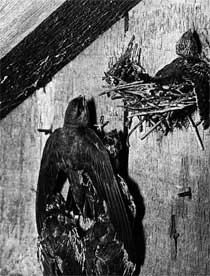 Chimney Swift: The Chimney Swift (Chaetura pelagica) is a small swift. In flight, this bird looks like a flying cigar with long slender curved wings. The plumage is a sooty grey-brown; the throat, breast, underwings and rump are paler. They have short tails. Chimney Swift: The Chimney Swift (Chaetura pelagica) is a small swift. In flight, this bird looks like a flying cigar with long slender curved wings. The plumage is a sooty grey-brown; the throat, breast, underwings and rump are paler. They have short tails.
What is a Nest But Saliva and Sticks? Their breeding habitat is near towns and cities across eastern North America. Originally, these birds nested in large hollow trees, but now they mainly nest in man-made structures such as large open chimneys. The nest is made of twigs glued together with saliva and placed in a
shaded location.
Range and Migration: They are long distance migrants and winter in eastern Peru; other nesting locations in South America may exist. They migrate in flocks. This species has occurred as a very rare vagrant to western Europe. the gregarious nature of this species is reflected in that two individuals of this species turned up together on the Isles of Scilly.
Flying Food: These birds live on the wing, foraging in flight. They eat flying insects. They usually feed in groups, flying closely together and making a high-pitched chipping noise. Their flight is distinctive: they make rapid angular turns unlike most other birds. They are most often active at dusk, where they are frequently heard before they are seen.
A Swift's Home is His Chimney: Their population may have increased with the availability of large chimneys as nesting locations. With suitable man-made habitat becoming less common, their numbers may be declining in some areas.

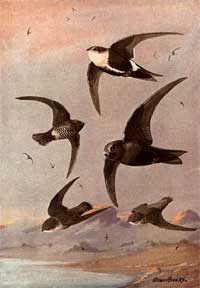 Taxonomy: In the Sibley-Ahlquist taxonomy, the old order Apodiformes is split. Swifts remain in that order, but hummingbirds are put into a new order, Trochiliformes. Taxonomy: In the Sibley-Ahlquist taxonomy, the old order Apodiformes is split. Swifts remain in that order, but hummingbirds are put into a new order, Trochiliformes.
The taxonomy of this group is in general complicated, with genus and species boundaries widely disputed, especially amongst the swiftlets.
The treeswifts are closely related to the true swifts, but form a separate family.
Species list:
Tribe Cypseloidini
- Chestnut-collared Swift, Cypseloides rutilus
- Tepui Swift, Cypseloides phelpsi
- Black Swift, Cypseloides niger
- White-chested Swift, Cypseloides lemosi
- Rothschild's Swift, Cypseloides rothschildi
- Sooty Swift, Cypseloides fumigatus
- Spot-fronted Swift, Cypseloides cherriei
- White-chinned Swift, Cypseloides cryptus
- White-fronted Swift, Cypseloides storeri
- Great Dusky Swift, Cypseloides senex
- White-collared Swift, Streptoprocne zonaris
- Biscutate Swift, Streptoprocne biscutata
- White-naped Swift, Streptoprocne semicollaris
Tribe Collocaliini - swiftlets
- Waterfall Swift, Hydrochous gigas
- Glossy Swiftlet, Collocalia esculenta
- Cave Swiftlet, Collocalia linchi
- Pygmy Swiftlet, Collocalia troglodytes
- Seychelles Swiftlet, Aerodramus elaphrus
- Mascarene Swiftlet, Aerodramus francicus
- Indian Swiftlet, Aerodramus unicolor
- Philippine Swiftlet, Aerodramus mearnsi
- Moluccan Swiftlet, Aerodramus infuscatus
- Mountain Swiftlet, Aerodramus hirundinaceus
- White-rumped Swiftlet, Aerodramus spodiopygius
- Australian Swiftlet, Aerodramus terraereginae
- Himalayan Swiftlet, Aerodramus brevirostris
- Indochinese Swiftlet, Aerodramus rogersi
- Volcano Swiftlet, Aerodramus vulcanorum
- Whitehead's Swiftlet, Aerodramus whiteheadi
- Bare-legged Swiftlet, Aerodramus nuditarsus
- Mayr's Swiftlet, Aerodramus orientalis
- Palawan Swiftlet, Aerodramus palawanensis
- Mossy-nest Swiftlet, Aerodramus salangana
- Uniform Swiftlet, Aerodramus vanikorensis
- Palau Swiftlet, Aerodramus pelewensis
- Guam Swiftlet, Aerodramus bartschi
- Caroline Islands Swiftlet, Aerodramus inquietus
- Atiu Swiftlet, Aerodramus sawtelli
- Polynesian Swiftlet, Aerodramus leucophaeus
- Marquesan Swiftlet, Aerodramus ocistus
- Black-nest Swiftlet, Aerodramus maximus
- Edible-nest Swiftlet, Aerodramus fuciphagus
- German's Swiftlet, Aerodramus germani
- Papuan Swiftlet, Aerodramus papuensis
- Scarce Swift, Schoutedenapus myoptilus
- Schouteden's Swift, Schoutedenapus schoutedeni
Tribe Chaeturini - needletails
- Philippine Spinetail, Mearnsia picina
- Papuan Spinetail, Mearnsia novaeguineae
- Malagasy Spinetail, Zoonavena grandidieri
- Sao Tome Spinetail, Zoonavena thomensis
- White-rumped Needletail, Zoonavena sylvatica
- Mottled Spinetail, Telacanthura ussheri
- Black Spinetail, Telacanthura melanopygia
- Silver-rumped Needletail, Rhaphidura leucopygialis
- Sabine's Spinetail, Rhaphidura sabini
- Cassin's Spinetail, Neafrapus cassini
- Bat-like Spinetail, Neafrapus boehmi
- White-throated Needletail, Hirundapus caudacutus
- Silver-backed Needletail, Hirundapus cochinchinensis
- Brown-backed Needletail, Hirundapus giganteus
- Purple Needletail, Hirundapus celebensis
- Band-rumped Swift, Chaetura spinicauda
- Lesser Antillean Swift, Chaetura martinica
- Gray-rumped Swift, Chaetura cinereiventris
- Pale-rumped Swift, Chaetura egregia
- Chimney Swift, Chaetura pelagica
- Vaux's Swift, Chaetura vauxi
- Chapman's Swift, Chaetura chapmani
- Short-tailed Swift, Chaetura brachyura
- Ashy-tailed Swift, Chaetura andrei
Tribe Apodini - typical swifts
- White-throated Swift, Aeronautes saxatalis
- White-tipped Swift, Aeronautes montivagus
- Andean Swift, Aeronautes andecolus
- Antillean Palm Swift, Tachornis phoenicobia
- Pygmy Swift, Tachornis furcata
- Fork-tailed Palm Swift, Tachornis squamata
- Lesser Swallow-tailed Swift, Panyptila cayennensis
- Great Swallow-tailed Swift, Panyptila sanctihieronymi
- Asian Palm Swift, Cypsiurus balasiensis
- African Palm Swift, Cypsiurus parvus
- Alpine Swift, Apus melba
- Mottled Swift, Apus aequatorialis
- Alexander's Swift, Apus alexandri
- Common Swift, Apus apus
- Plain Swift, Apus unicolor
- Nyanza Swift, Apus niansae
- Pallid Swift, Apus pallidus
- African Swift, Apus barbatus
- Forbes-Watson's Swift, Apus berliozi
- Bradfield's Swift, Apus bradfieldi
- Madagascar Swift, Apus balstoni
- Pacific Swift, Apus pacificus
- Dark-rumped Swift, Apus acuticauda
- Little Swift, Apus affinis
- House Swift, Apus nipalensis
- Horus Swift, Apus horus
- White-rumped Swift, Apus caffer
- Bates' Swift, Apus batesi
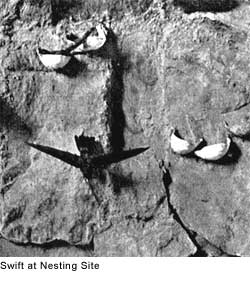
All text is available under the terms of the GNU Free Documentation License
|